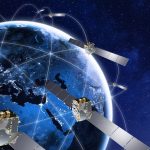The four Galileo in-orbit validation (IOV) satellites now on orbit have begun broadcasting the “offset” between the GPS and Galileo system time, accurate to a few billionths of a second, according to the European Space Agency.
With satellite navigation based around the highly accurate measurement of signal travel times, both Galileo and GPS have their own internal reference time systems used to synchronize all system clocks, including those in the ground segment, on satellites, and in receivers. Galileo System Time is about 50 nanoseconds or less apart from GPS time.
The four Galileo in-orbit validation (IOV) satellites now on orbit have begun broadcasting the “offset” between the GPS and Galileo system time, accurate to a few billionths of a second, according to the European Space Agency.
With satellite navigation based around the highly accurate measurement of signal travel times, both Galileo and GPS have their own internal reference time systems used to synchronize all system clocks, including those in the ground segment, on satellites, and in receivers. Galileo System Time is about 50 nanoseconds or less apart from GPS time.
“A nanosecond is only a billionth of a second, corresponding to the time light takes to travel 30 centimeters,” explains Jörg Hahn, Galileo System Engineering Manager.
“But this soon adds up, and anyone attempting to use the two systems together might find this ‘offset’ accounting for up to 15 meters of error, causing an unacceptable contribution to user performance.”
Currently, this time offset needs to be known or estimated by the receiver itself. Formally known as the GPS to Galileo time offset, or GGTO, its inclusion in the broadcast navigation message of satellite signals is projected to improve the accuracy of the offset to five nanoseconds or less.
“The dissemination of the GPS to Galileo offset can help in constrained environments such as city centers, where only a few satellites are visible in the sky,” adds Jörg. “The receiver can then take this offset and align all the observations to a single time scale, reducing the computational burden on the receiver since the amount of unknowns are decreased.”
ESA officials believe that disseminating the offset will help encourage manufacturers to start incorporating Galileo into GNSS receiver designs — even at this early stage with only four satellites yet in orbit.
Galileo runs on Galileo system time (GST), which is generated on the ground at the Galileo Control Center in Fucino, Italy, by the Precise Timing Facility (PTF), based on averages of different atomic clocks. GPS system time is computed by the GPS control segment using an assembly of clocks — the GPS Composite Clock, which consists of all operational monitor station and satellite frequency standards. GPS system time, in turn, is referenced to the U.S. Naval Observatory’s Master Clock and steered to Coordinated Universal Time — UTC(USNO), corrected for leap seconds (which GPS time doesn’t use).
These two internal times are derived independently of one another but are kept close to the world’s reference time, coordinated universal time or UTC, with the offset between the two being precisely calculated on a continuous basis for the Galileo system by the PTF.
GPS and Galileo share some frequencies (L1/E1 at 1575.420 MHz and L5/E5a at 1176.450 MHz) with a view to interoperability, and disseminating the GGTO makes using the two systems together more straightforward.
“GGTO determination methods and interface design were agreed on a preliminary basis between the Galileo Project and the US Naval Observatory back in 2003, through a GGTO subgroup of the US and EU Working Group A on Compatibility and Interoperability,” Jörg concludes. “We’ve worked together closely since then to make the GGTO a reality.”
A explanation of GNSS system offsets and how to calculate the differences amonog them appears in the GNSS Solutions column in the May/June issue of Inside GNSS. An article by ESA authors addressing the specific implementation of GGTO in the Galileo navigation message will appear in a future issue of Inside GNSS.





